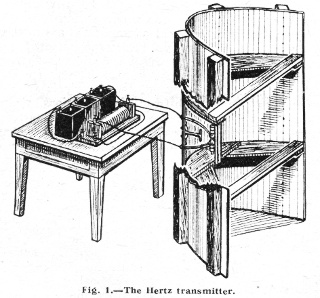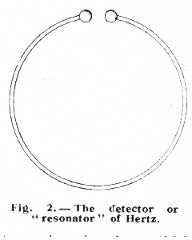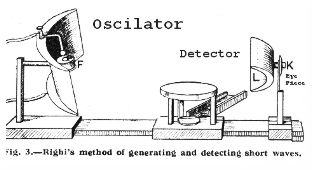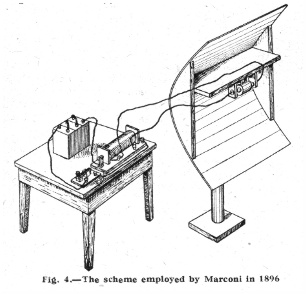The Short Wave
23rd September 1925. The Short Wave - Its discovery, abandonment and revival.By A H Morse A.M.I.E.E., Member I.R.E. (MD of Marconi Canada)
IN the beginning one Huygens, a Dutch scientist, propounded a theory that light was transmitted by means of waves. In 1864, nearly two centuries later, this theory was mathematically confirmed by that great-but all-too-short-lived-Englishman, Clerk-Maxwell. In 1888 it was experimentally proved by Prof. Heinrich Hertz, of Carlsruhe.
Discovery
Clerk-Maxwell's confirmation of Huygens theory was predicated upon the assumption that the waves were electromagnetic in character; and Hertz's experiments were made with such waves of an invisible order of length- that is, many times longer than the longest which reveal themselves as red in the solar spectrum.
It is true that, in 1879, an Englishman named D. E. Hughes made experimental use of these waves, and also that in 1883 another Englishman named Fitzgerald disclosed a method of producing "Electro-Magnetic Disturbances of Com- paratively Short Wavelengths," (BA, 1883) wherein it was shown how to generate waves of a length of two metres.
However, both Hughes and Fitzgerald seem to have been a decade ahead of their time, for the attention of experimental scientists was not directed to this field of research until well on in the 1890's. Then, Hertz's experiments becoming known, such men as Lodge and Rutherford in England, Righi and Marconi in Italy, Popoff in Russia, and others, were moved to interest themselves therein.
(The reader who may have not yet fully grasped the fact that all the waves used in "Radio" are identical in character with those radiated by the sun, would do well to study Sylvanus P. Thompson's lecture on the "Invisible Spectrum"- Light Visible and Invisible, Macmillan, 1897)
In view of the fact that the application of the laws of optics to what are now known as Hertzian or "Radio" waves increases in difficulty as the length of wave increases, it is not surprising to note that the very early experimenters- who, moreover, had not the means to generate long waves-made free use of parabolic and other reflectors; etc.; albeit they had no means of producing persistent radio-frequency waves of any length.


Thus we find that Hertz used a transmitting arrangement as shown in Fig. 1, and a detector or "resonator" of the well-known ring form, as in Fig. 2.
By means of the former he was enabled to project a beam, and by means of the latter he was enabled to measure the length of the waves of which it was constituted.
 Righi's method of generating and detecting short waves is illustrated in Fig. 3, wherein the oscillator is marked F, and the detector L is a parabolic mirror in the focus of which are two strips of silver foil, separated by a
diamond cut. Across this cut, sparks take place, which may be seen through the eye-piece K.
Righi's method of generating and detecting short waves is illustrated in Fig. 3, wherein the oscillator is marked F, and the detector L is a parabolic mirror in the focus of which are two strips of silver foil, separated by a
diamond cut. Across this cut, sparks take place, which may be seen through the eye-piece K.
It is recorded that by means of this device Righi generated and observed waves of from one to eight inches in length.
Abandonment
It was not until 1892 that anyone appears to have considered the possibility of using short (or any other) radio waves for telegraphy, but in that year Sir William Crookes made the following statement in The Fortnightly Review -
Rays of light will not pierce through a wall, nor, as we know only too well, through a London fog; but electrical vibrations of a yard or more in wavelength will easily pierce such media, which to them will be transparent.
Here is revealed the bewildering possibility of telegraphy without wires, posts, cables, or any of our present costly appliances. Granted a few reasonable postulates, the whole thing comes well within the realms of possible fulfilment. At present experimentalists are able to generate electric waves of any desired length, and to keep up a succession of such waves radiating into space in all directions. It is possible, too, with some of these rays, if not with all, to refract them through suitably shaped bodies acting as lenses, and so direct a sheaf of rays in any given direction. Also, an experimentalist at a distance can receive some, if not all, of these rays on a properly constituted instrument, and by concerted signals messages in the Morse code can thus pass from one operator to another” (see pp. 197, 198, Fahie's "History of Wireless Telegraphy" Blackwood).
Again, in 1895, it is recorded of Prof. Popoff, of St. Petersburg (now Leningrad), that he transmitted the words "Heinrich Hertz" by means of the Morse code and Hertzian or "Radio" waves.
 Then, in 1896 we have Marconi proposing the use of reflected short waves for telegraphic purposes (see Fig. 4) (British Patent 12039/96); but in the following vear, when he filed his "complete" specification, he appears to have had more faith in longer waves, although he mentions having used waves of ten inches in length; and in 1899 we find Ferdinand Braun preaching the gospel of the longer wave. (British Patents 1862 and 22020 of 1899).
Then, in 1896 we have Marconi proposing the use of reflected short waves for telegraphic purposes (see Fig. 4) (British Patent 12039/96); but in the following vear, when he filed his "complete" specification, he appears to have had more faith in longer waves, although he mentions having used waves of ten inches in length; and in 1899 we find Ferdinand Braun preaching the gospel of the longer wave. (British Patents 1862 and 22020 of 1899).
Meantime Tesla had disclosed efficient methods, which are still in use, for the generation of damped trains of waves of almost any length. (British patents 8575 of 1891, and 20981 of 1896).
If he be a layman, the reader may ask how the very great efficiency of short waves has so long awaited recognition. The answer is "It has not."
One swallow does not make a summer. Neither does one wave make a signal, and until comparatively recently it has not been possible to generate more than about one short wave at a time. A single wave is about as useless as a single tooth; for the art of efficient radio communication turns upon the cumulative effect of resonance, whereby feeble but persistent and resonant impulses create astonishing effects.
Occasional and irregular impulses are useless, particularly in short-wave working. An oscillating system having such a minute time-period as is necessary for the production of really short Hertzian Waves obviously cannot have much energy capacity. If, therefore, it is to be of practical use as a transmitter, it must be excited by persistent oscillations of ultra-high and appropriate frequency. But, although a generator of such oscillations was evolved by Meissner, in Germany, in 1913, it found no extensive application-as such-until some ten years later.
In the early experimental days of radio the instrumentalities available were sufficient only to demonstrate the potentialities of short Hertzian waves and their identity with light waves; they were of no use for syntonic commercial telegraphy.
The shorter the wave the more persistent it must be, for on persistence depends not only efficiency, or range, but the equally vital quality of syntony; in fact, in successful short-wave working the latter is not merely an ideal, but an achievement.
Neither the arc nor the alternator could be made to generate waves which could be described as "short"; and the various "spark" methods of generating radio-frequency waves were out of the question, because of their irregularity. Thus, the short wave, for practical purposes, was still-horn.
Revival
The growth of the use of "spark" telegraphy naturally led to a wider technical interest in the subject. As a consequence, there came into existence an ever-increasing number of amateur experirnenters, who began to saw the ether with their raucous and more-or-less untuned apparatus, until control became inevitable.
The Navy, Army, Post Offce, commercial radio Companies, and amateur experimenters were all demanding all they could get of available wave-bands, and in the queue which eventually lined up for formal ethereal allotment the amateur was at the wrong end. He thus became possessed of what the others did not want, and that is how he acquired the right to experiment with short waves.
To that fact, and the subsequent development of the thermionic valve as a generator of very high-frequency oscillations, we undoubtedly owe much of the progress which has in recent years been made in short-wave technique; for the amateurs became legion, and they practised a free interchange of knowledge hitherto unknown and seldom practicable amongst professionals.
In 1913 Dr. Alex. Meissner, of Germany, by means of the thermionic valve succeeded in generating persistent or continuous waves of a length of only 5 metres; and in 1919 C. S. Franklin, of London, commenced experiments with the same device with a view to continuing the short-wave experiments, initiated by others with cruder apparatus some thirty years earlier.
Now "everybody's doing it," and intermittent two-way communications by amateurs over long distances and by means of very low power are almost commonplace.
In fact, we often read of such communications between places that are literally poles apart, by the use of no more energy than may be derived from a lamp-socket. These resu1ts, moreover, are accomplished by broadcast, as distinct from "beam" methods.
The deductions that may be drawn from the foregoing are manifold, and the chief is that there is little or no useful economy in power to be expected from the use of "beam" transmission over any really great distance- the "beam's" practicability for long-distance working has yet to be demonstrated.
Another is that unless the beam (as popularly understood) is restricted very much in its angular measurement, it can, as such, serve very little useful secrecy purpose, because of its great range.
Take, for instance, the case of a 30 degree beam of radiant energy of the order of 30 kW. : there is reason to believe that such a beam, when it is effective at all, will persist until it encircles and envelops the earth, and is detectable at any point.
Even broadcast short-wave signals, that are measured at the transmitter in terms of mere watts are reported to be quite strong in the Antipodes.
Therefore, there may he found to be no useful result, either in the way of secrecy, or ether or power economy, in using a 30 degree "beam" for long-distance communication. In fact, for the foregoing and other reasons, it seems likely that long-distance communication will he little aided by the "beam" method, as distinct from that proposed many years ago by Brown, Stone, Blondel, Braun, and others, a brief review of which follows.
S. G. Brown proposed in 1899 that the aerials should be a distance apart conveniently half that of the Hertzian wavelength, such an arrangement causing the positive radiating wire to supply the positive crest of the wave at the same time as the negative radiating wire supplies the negative crest of the wave, and the waves to be thus transmitted or received mainly in the direction of the plane of the radiating and receiving wires.
In the specification of Stone's development of this method in 1902, the inventor says that the principle employed is one that is the electrical analogue of the phenomenon of interference in sound and light.
At about the same time the matter engaged the attention of Blondel, who secured a claim on a radiator system for wireless telegraphy characterised by the combination of two or more practically parallel aerial or mast wires, the distances and phases of which are chosen dependently on the wavelength of the oscillations of the radiator, so that the Hertzian waves respectively radiated by said aerial or mast wires are concordant in phase in that plane in which the energy is to be transmitted, and are annulled in a perpendicular plane as hereinbefore described.
Which would not be bad practice, even in 1925.
This same method is also employed by Braun in his 1904 invention, which--- according to his American specification - is especially advantageous in connection with transmitting stations with several transmitting wires oscillating in different phase for radiating the waves in a definitive direction.
After 1904, for over a decade there seems to have been no further attempts to make use of what may be called "optical phenomena" in radio. But when Meissner had disclosed a method of generating persistent short-waves, interest in the subject seems to have revived.
Thus, in 1916 we find Marconi applying for a patent on a tuned parabolic reflector, and in the following year he joins forces with Franklin in an application for a patent on a device of a similar nature.
But in 1917 we find Alexanderson reverting to the principles exploited by Blondel and others, and claiming to have invented a method whereby he can obtain a directional effect comparable with the focussing of a beam of light by a lens or mirror
He is followed by Franklin, in 1923, with a somewhat similar device plus a tuned flat reflector.
The second decline of interest in parabolic reflectors which may now be noticed is due largely to the well- and long-known difficulties attendant on the use of such reflectors in conjunction with any but very short waves. However, its early revival may be expected, for there is little doubt that the "short" wave of to-day will tomorrow be considered long; moreover, when really short waves come to be used they will most certainly find wide practical application.
They will, for instance, be used in connection with both telegraphy, as proposed by Crookes in 1892, and aids-to-navigation, as proposed by Marconi in 1899.
Already, by their use with reflectors, etc., it is possible to provide almost certain automatic warning of the danger of collision between ships at sea; but unfortunately this is not yet done.
Obviously, the field for development and research is as great as ever it was. The thermionic va1ve for which we have to thank Edison, Fleming, and De Forest- has truly been an Aladdin's lamp to the radio engineer; and, in the able hands of such men as Armstrong, Franklin, Marconi, Meissner, and Round, we may expect it to light the way still farther into the unknown.
As an example, it may be the means of making feasible the generation of circularly polarised waves, as proposed by Herr Zehnder in 1894.
It is certain that, with the development of short-wave technique, we shall soon be able to enjoy secrecy of radio communication and practise ethereal economy to an extent that will solve many present difficulties and still further increase the great debt that mankind owes to radio.
Meantime it should be remembered that, scientifically, "beam" is a meaningless term. Hitherto it has been known mainly as a product of the sun-- the most powerful broadcaster in human ken. Time alone will prove to what extent the new use of the word connotes a different quality.